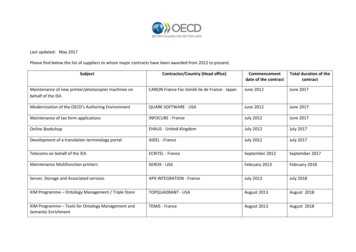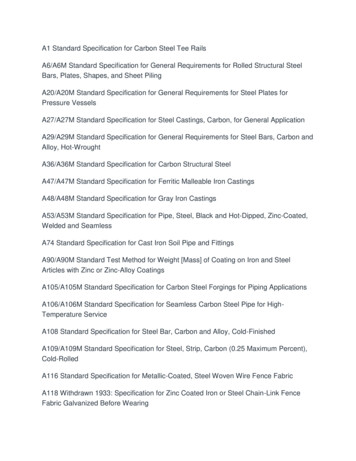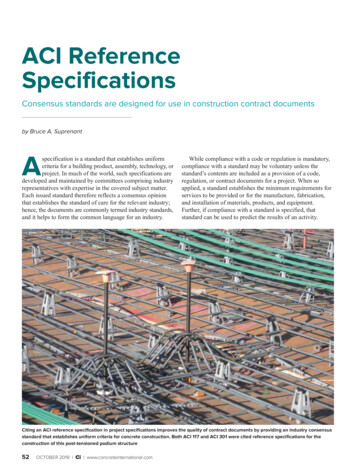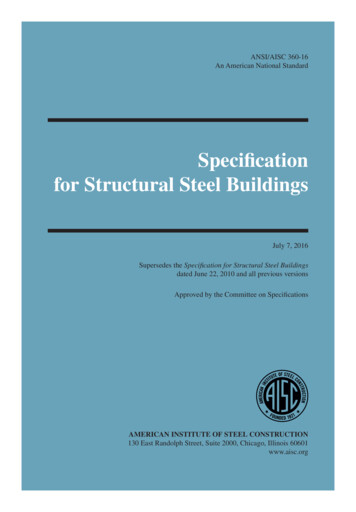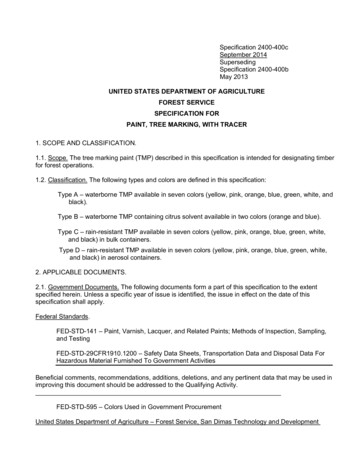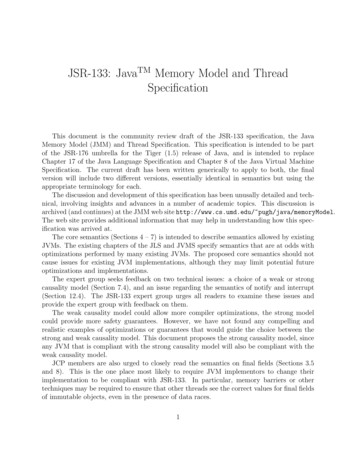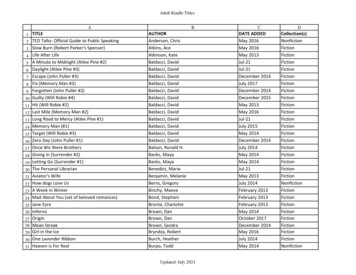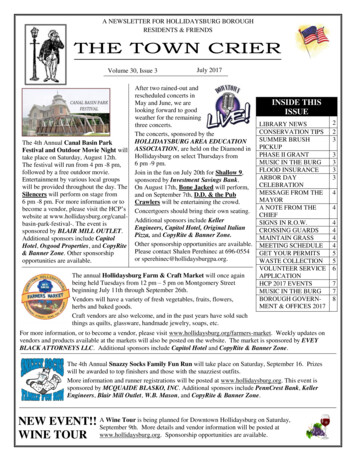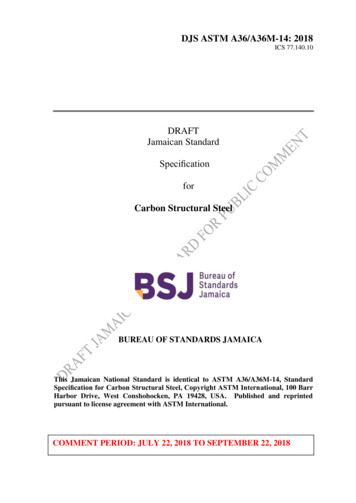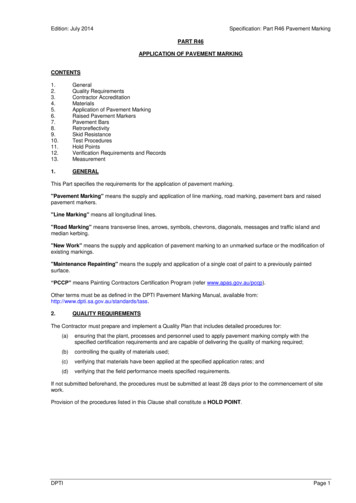
Transcription
Edition: July 2014Specification: Part R46 Pavement MarkingPART R46APPLICATION OF PAVEMENT alQuality RequirementsContractor AccreditationMaterialsApplication of Pavement MarkingRaised Pavement MarkersPavement BarsRetroreflectivitySkid ResistanceTest ProceduresHold PointsVerification Requirements and RecordsMeasurement1.GENERALThis Part specifies the requirements for the application of pavement marking."Pavement Marking" means the supply and application of line marking, road marking, pavement bars and raisedpavement markers."Line Marking" means all longitudinal lines."Road Marking" means transverse lines, arrows, symbols, chevrons, diagonals, messages and traffic island andmedian kerbing."New Work" means the supply and application of pavement marking to an unmarked surface or the modification ofexisting markings."Maintenance Repainting" means the supply and application of a single coat of paint to a previously paintedsurface.“PCCP” means Painting Contractors Certification Program (refer www.apas.gov.au/pccp).Other terms must be as defined in the DPTI Pavement Marking Manual, available ALITY REQUIREMENTSThe Contractor must prepare and implement a Quality Plan that includes detailed procedures for:(a)ensuring that the plant, processes and personnel used to apply pavement marking comply with thespecified certification requirements and are capable of delivering the quality of marking required;(b)controlling the quality of materials used;(c)verifying that materials have been applied at the specified application rates; and(d)verifying that the field performance meets specified requirements.If not submitted beforehand, the procedures must be submitted at least 28 days prior to the commencement of sitework.Provision of the procedures listed in this Clause shall constitute a HOLD POINT.DPTIPage 1
Edition: July 20143.Specification: Part R46 Pavement MarkingCONTRACTOR ACCREDITATIONThe work must be undertaken by a company that has PCCP accreditation appropriate for the type of work beingundertaken in accordance with Table 3.TABLE 3. PCCP ACCREDITATIONClassAccreditation Class DescriptionMaterialsSub-class20Long-run longitudinal pavement marking on majorroadsPaintClass 20-121Short to medium-run longitudinal pavement markingon minor roadsPaintClass 21-123Pavement marking; Car parkPaintClass 23-1ThermoplasticClass 24-224Transverse pavement marking includingintersections & messagingMulti-component/CAPClass 24-3Non-skid PaintClass 24-425Raised Pavement Marker/Pavement Bar Installation26High Friction Surfacings27Pavement marking; Removal4.Class 25-1Coloured Bus/Cycle LanesClass 26-2Class 27-1MATERIALSAll pavement marking materials must comply with Part R45 "Supply of Pavement Marking Materials".5.APPLICATION OF PAVEMENT MARKING5.1GeneralMarkings must be as detailed on the Drawings and in accordance with the DPTI Pavement Marking Manual.The application of pavement marking to the road surface must only take place under the following conditions:(a)When the surface is dry and free from foreign matter (e.g. oil, loose material, sealing aggregate, etc);(b)At air temperatures 10 C; and(c)When relative humidity is 85%.Subject to prior approval, the manufacturer’s written recommendations must be used if at variance with these criteria.All data must be recorded in the daily diary.The Contractor must undertake mechanical or hand brooming if condition (a) above cannot be achieved by use of asurface cleaning apparatus incorporated in the line marking machine.5.2Protection of WorkUntil full curing of the pavement marking has been achieved, the Contractor must ensure that all work is protected fromtraffic damage by the use of cones and signs in accordance with AS 1742.3, Clause 3.9.1.If "pick-up" is evident the Contractor must obliterate any "re-distributed” material caused by vehicles passing overuncured work by removing and/or covering the "re-distributed" material with a treatment of appropriate colour andtype to match the existing road surface.The Contractor must reapply pavement marking damaged by vehicles passing over uncured work.Longitudinal line marking must be considered damaged where the initial retroreflectivity measured within 10 days ofapplication using a calibrated low angle retroreflectometer using 30 metre geometry is below 240 mcd/m2/lx.5.3Spotting AlignmentFor new work, the Contractor must carry out spotting prior to the application of all pavement markings. Followingspotting, the Contractor must give 24 hours notice before any pavement marking is applied.DPTIPage 2
Edition: July 2014Specification: Part R46 Pavement MarkingProvision of the above notice shall constitute a HOLD POINT.5.4Paint Application - GeneralUnless specified otherwise, longitudinal line work in rural areas must be undertaken with a Class A line markingmachine. Longitudinal line marking in the metropolitan area must be undertaken with a Class A line marking machineif practicable, otherwise a Class B line marking machine must be used. Refer to the PCCP for details of Class A andClass B line marking machines.Hand spraying with the use of templates to control the pattern and shape will be allowed for transverse lines,chevrons, diagonals, pavement messages, symbols and traffic island and median kerbing.Where two coats of paint are to be applied for separation lines on carriageways with two-way traffic, the coats mustbe applied in opposite directions. Paint for separation lines on carriageways with one-way traffic and all edge linesmust be applied in the direction of traffic.Where two coats of paint are to be applied, the first coat must be adequately cured prior to the application of thesecond coat. All paint and beads must be evenly applied to the markings.The time and date of installation of regulatory lines must be recorded and the Contractor must forward thisinformation within 5 working days.5.5Longitudinal Paint SystemsThe longitudinal paint system must be as described in Table 5.5:TABLE 5.5TREATMENTStandardMATERIALSTYPICAL APPLICATIONPaint and Type B highretroreflectivity drop on beads(traditionally referred to as“virgin”, “pristine” or “highrefractive index” beads).Roads where standard performance and limited wetweather reflectivity is acceptable.Large BeadsPaint and Type D-HR largebeads.High traffic volume roads where enhancedperformance and wet weather retroreflectivity isrequired. This treatment will typically halvemaintenance requirements.Large Bead/GlassAnti Skid MixPaint and Type D-HR largebead/glass anti skid mix.High traffic volume roads where enhancedperformance and wet weather retroreflectivity isrequired and skid resistance must be provided on asmooth road surface. This treatment will typicallyhalve maintenance requirements.Large beads and / or the Large Bead/Glass Anti Skid Mix must be used when specified in the Contract SpecificRequirements.5.6Transverse “Non-skid” Marking SystemsThe transverse paint system must be as described in Table 5.6:DPTIPage 3
Edition: July 2014Specification: Part R46 Pavement MarkingTABLE 5.6TREATMENTMATERIALSTYPICAL APPLICATIONStandardPremixed paint and crushedquartz.Roads and intersections where skid resistance isrequired but no retroreflectivity.High performanceMulti Component2 part cold applied material,aggregate and Type D-HRlarge beads with an adhesioncoating.High traffic volume roads and intersections with alarge number of heavy vehicles where enhancedperformance and dry and wet weatherretroreflectivity is required. This treatment willtypically have a 5 year life span.High PerformancePre-FormThermoplasticThermoplastic material andanti-skid mixture containingType C Intermix glass beadsand crushed glass.High traffic volume roads and intersections whereenhanced performance and retroreflectivity isrequired. This treatment will typically have a 5 yearlife span.High performance markings must be used when specified in the Contract Specific Requirements.5.7Longitudinal Paint Application (PCCP Class 20-1 and 21-1)(a)New Work(a)Standard TreatmentTwo coats of paint must be applied during the same site visit(b)Large Beads and Large Bead/Glass Anti Skid TreatmentTwo coats of paint must be applied. The first coat must be the Standard Treatment and the second coatthe Large Bead Treatment.Two coats of paint must be applied together with a concurrent application of beads. The first coat must be fully curedprior to the application of the second coat. The timing of the application of paint must comply with any requirementsspecified in the Contract Specific Requirements.Until installation of the separation line, the Contractor must maintain appropriate signing in accordance with AS 1742(e.g. T3-12 "No lines do not overtake unless safe") and Part CH20 "Provision for Traffic".(b)Maintenance RepaintingOne coat of the specified paint treatment must be applied together with a concurrent application of glass beads.5.8Transverse "Non-skid" Paint Application (PCCP Class 24-4)(a)New WorkTwo coats of pre-mixed paint and crushed quartz must be applied during the same site visit. The first coat must befully cured prior to the application of the second coat.(b)Maintenance RepaintingOne coat of pre-mixed paint and crushed quartz must be applied.5.9Transverse High Performance Pavement Marking Application(a)Multi Component (PCCP Class 24-3)Consists of a 2 part cold applied pavement marking material applied according to the manufacturer’srecommendations and comprising:(a)A base coat(b)Aggregate(c)A top coat to encapsulate the aggregate(d)Type D-HR beads with an adhesion coating.The aggregate and beads must be applied while the material is fluid to ensure embedment and must be evenlydistributed to provide a complete coverage.DPTIPage 4
Edition: July 2014(b)Specification: Part R46 Pavement MarkingPre-Form Thermoplastic Pavement Marking (PCCP Class 24-2)Consists of pre-formed thermoplastic pavement marking material applied according to the manufacturer’srecommendations. An anti-skid mixture containing Type C Intermix glass beads and crushed glass must be appliedimmediately after heating while the material is still liquid. The mixture must be evenly distributed to provide acomplete coverage of the surface of the thermoplastic.5.10Coloured Pavement Surfacings Application (PCCP Class 26-2)Coloured pavement surfacings for use on pavement designated as bus or cycle lanes.(a)Multi ComponentConsists of a suitably pigmented 2 part cold applied pavement marking material applied according to themanufacturer’s recommendations and comprising:(a)A base coat(b)Aggregate(c)A top coat to encapsulate the aggregateThe aggregate must be applied while the material is fluid to ensure embedment and must be evenly distributed toprovide a complete coverage.(b)Pigmented Binder SystemConsists of a 2 or more component thermosetting resin suitably pigmented to provide the necessary depth ofspecified colour in the finished surface coating and the application of coloured aggregate. The aggregate must beapplied while the material is fluid to ensure embedment and must be evenly distributed to provide a completecoverage of the treated area.5.11Kerb Treatment(a)New WorkThe concrete surface of the kerb must be dry and adequately cured prior the application of paint, and any curingagents used must be removed by an appropriate means. The paint must be applied in one or more coats to achievethe specified minimum dry thickness. Glass beads must be applied to the final coat immediately following theapplication of paint to ensure embedment and retention.(b)Maintenance RepaintingThe Contractor must remove and dispose of any lifting or flaking paint coatings, rubbish, grass and vegetation toachieve a sound surface prior the application of paint. Repainting must consist of a single application of paint toachieve the specified minimum dry film thickness. Glass beads must be applied to immediately following theapplication of paint to ensure embedment and retention. The Contractor must ensure that "over-spray" does notcause paint contamination to adjacent surfaces.5.12Glass Bead and Glass Bead/Anti Skid ApplicationAll beads and bead/anti skid mix must be applied using a method that ensures uniform cover and retention to thesurface of the marking, and minimal wastage of material. The Contractor must ensure excessive application ofmaterial, which may present a hazard for road users, does not occur. Glass beads and glass bead/anti skid mix mustbe applied immediately following application of pavement marking material to ensure embedment and retention.5.13Pavement Marking Application RatesPavement marking and additives must be applied in accordance with Table 5.13 "Pavement Marking Application".Written verification of all application rates must be provided, vide Clause 12 "Verification Requirements and Records".DPTIPage 5
Edition: July 2014Specification: Part R46 Pavement MarkingTABLE 5.13PAVEMENT MARKING APPLICATIONPAINTADDITIVEITEM TO BE TREATEDTYPECOLOURFILM THICKNESSTYPERATEMin. Retained275 g/m2Min. Retained500 g/m2Longitudinal LinesStandard BeadsWaterbornepavementmarkingWhiteWet 300 – 375 m.Type B HighRetroreflectivityDrop-on GlassBeadsLongitudinal LinesLarge BeadsWaterbornepavementmarkingWhiteWet 600 m.Type D-HR Largewet weather GlassBeadsLongitudinal LinesLarge Bead/Glass antiskid mixWaterbornepavementmarkingWhiteWet 600 m.Type D-HR Large Min. Retainedwet weather Glass750 g/m2Bead and1 mm – 2 mmcrushed glass mix Mix Ratio 70:30Pavement messages,symbols, chevrons,diagonals & transverselinesWaterbornepavementmarkingWhiteDry 250 – 350 m.Premixed withCrushed QuartzWhiteYellowBase coat 1mmTop coat 0.5 mm1-3 mm aggregateType D-HR Largewet weather GlassBeads withadhesion coatingWhiteYellowPre-Form Thickness2.5 mm 0.5 mmVariousBase coat 1 mmTop coat 0.5 mmHighPerformancePavement messages,Multi Componentsymbols, chevrons,merge arrows,diagonals & cMulti ComponentBus and Cycle LanesPigmentedBinderVariousDPTILatex exterior flator low glossWhite400 gm/m2400 gm/m2Type C Intermix1.60 Kg/m2Glass Bead andretained1 mm – 2 mmMix Ratio 70:30crushed glass mix1-3 mm aggregate1.50 Kg/m2BinderUniform thickness toprovide adhesion to 1-3 mm aggregateaggregate andsubstrateCompletecoverage oftreated areaNew: dry 60 – 90 m.Traffic island andmedian kerbingMin. 0.50 kg/LMaintenance:dry 40 – 60 m.Type B HighRetroreflectivityDrop-on GlassBeadsMin. Retained275 g/m2Page 6
Edition: July 2014Specification: Part R46 Pavement MarkingNew: dry 60 – 90 m.Pavement barsLatex exterior flator low glossYellowType B HighRetroreflectivityDrop-on GlassBeadsMin. Retained275 g/m2Wet 300 – 375 m.Type B HighRetroreflectivityDrop-on GlassBeadsMin. Retained275 g/m2Min. Retained275 g/m2Maintenance:dry 40 – 60 m.Clearway markingsWaterbornepavementmarkingNo standing zonesWaterbornepavementmarkingYellowWet 300 – 375 m.Type B HighRetroreflectivityDrop-on ckDry 250 –350 m.Premixed withCrushed QuartzMin. 0.50 kg/LRail crossing boxhatchingsWaterbornepavementmarkingYellowDry 250 –350 m.Premixed withCrushed QuartzMin. 0.50 kg/L5.14YellowPlacement of MarkingsFor maintenance repainting, the existing road markings must be repainted to restore the original size, shape and linepattern. Pavement marking must be placed on the road surface in correct position within the following tolerancesspecified in Table 5.14.TABLE 5.14PLACEMENT OF MARKINGSNEW WORKMAINTENANCE REPAINTINGSPOTTINGLine marking 50 mm of pavement/ sealcentre or to surveyed designstrings-Road marking 50 mm of drawing dimensionsand control lines-ROAD MARKING 25 mm in relation to "spotting"Areas must not be less than existingshape and size and not more than10 mm greater than the existing allround (i.e. 0, 10 mm).Edgeline distance from centreline 25 mm-Resultant lane width 50 mm-Lateral deviation from "spotting" 25 mm-Stripe width 10, - 0 mm 10, - 0 mmStripe length, less than 12 m 150, - 0 mm 150, - 0 mmStripe length, greater than 12 m 300, - 0 mm 300, - 0 mmModule length, 12 m 150, - 0 mm 150, - 0 mmModule length, greater than 12 m 300, - 0 mm 300, - 0 mm"New over old" line placement (lateral)- 10 mm"New over old" line placement(longitudinal)- 150, - 0 mmLINE MARKINGDPTIPage 7
Edition: July 20145.15Specification: Part R46 Pavement MarkingNo Overtaking ZonesThe Contractor must accurately locate the extent of no overtaking zones from the Drawings prior to thecommencement of works. To locate zones the Contractor must use a calibrated, precise vehicle mounted measuringdevice capable of measuring to 1 m accuracy. If any discrepancies are identified the Contractor must provideimmediate notification. Under no circumstances must the Contractor install new or modify existing installations.5.16Removal of Pavement Markings (PCCP Class 27-1)Removal of pavement marking must be undertaken so as to not adversely affect the skid resistance, texture depth,susceptibility to ponding and appearance of the road surface. The Contractor must obtain approval of the proposedremoval method prior to undertaking the removal. Any materials produced by removal activity must be immediatelycollected and removed from site and disposed of in an environmentally acceptable manner.5.17Transition between Existing and New WorkThis sub-clause applies where a change of lane width after resealing works or road reconstruction results in a missmatch of an edge line. Where this occurs, the Contractor must ensure that the edge lines transition smoothlybetween the old and new work. Unless specified otherwise, a transition treatment must be made as indicated inFigure 5.16. The existing edge line and RRPM’s must be removed from the existing pavement and the new edge linemust transition between the old and new work on the existing pavement. The transitional line marking treatment mustnot be applied to new pavement work.New pavement workStart of new workExisting pavementObsolete RRPM’s andedgelines to be removed overtransition distanceMinimum transitiontreatment distance 24 mEdge LinesFigure 5.16Edge line Mismatch Treatment6.RAISED PAVEMENT MARKERS (PCCP Class 25-1)Installation of raised pavement markers must be in accordance with the DPTI Pavement Marking Manual if there areno drawings applicable. Markers must be placed to a tolerance of 25 mm.Adhesive must be two-part epoxy or hot melt used in accordance with the manufacturer’s instructions and appliedevenly over the whole contact surface area of the marker so that a bead of adhesive forms around the perimeterwhen the marker is pressed onto the road surface during installation.If removal of raised pavement markers is required, the Contractor must remove the marker and adhesive in such away that minimum damage is caused to the road surface. Any damage to a wearing surface must be repaired by anapproved method. Markers removed from the road must be collected and disposed of.7.PAVEMENT BARS (PCCP Class 25-1)Installation must be carried out such that the pavement bars are placed true to the locations indicated on theDrawings. Bars must be placed to a tolerance of 25 mm. Pavement bars must be treated with a paint/beadapplication in one or more coats to achieve the specified paint and glass bead application rates.DPTIPage 8
Edition: July 2014Specification: Part R46 Pavement MarkingAdhesive must be two part epoxy or hot melt used in accordance with the manufacturer’s instructions and appliedevenly over the whole contact surface area of the bar so that a bead of adhesive forms around the perimeter whenthe bar is pressed onto the road surface during installation.If removal of pavement bars is required, the Contractor must remove the bar and adhesive in such a way that minimumdamage is caused to the road surface. Remaining adhesive deposits must be removed to surface level to give atextured surface finish. The bar must be disposed of appropriately and any surface damage repaired. The method ofrepair must be subject to prior approval.If maintenance repainting of pavement bars is required, bars must be treated with a paint/bead application to achievethe specified paint and glass bead application rates. Precautions must be taken to avoid "overspray" and damage bytraffic whilst drying.8.RETROREFLECTIVITYThe measurement of retroreflectivity, as referenced in TP 950, must be carried out using a low angleretroreflectometer using 30 metre geometry calibrated to a nationally recognised reference standard. If theretroreflectivity at any test location should fall below the value shown in Table 246.8, the affected area, as defined inTP 950, must have the pavement marking re-applied.TABLE 246.8RETROREFLECTIVITYAADTE* 10 000 vehicles per dayDays of Wear10 to 20160 to 180360 to 380Retroreflectivity, mcd/m2/lx240165No requirement specifiedAADTE 4 000 to 10 000 vehicles per dayDays of Wear10 to 20160 to 180360 to 380Retroreflectivity, mcd/m2/lx240175No requirement specified10 to 20160 to 180360 to 380240220No requirement specified10 to 20160 to 180360 to 380265235225AADTE 1 000 to 4 000 vehicles per dayDays of WearRetroreflectivity,mcd/m2/lxAADTE 1 000 vehicles per dayDays of WearRetroreflectivity,mcd/m2/lx* Annual Average Daily Traffic Estimates.9.SKID RESISTANCESkid resistance for transverse marking must be greater than 45 BPN, until at least the issue of the Final Certificate,when measured in accordance with TP344 or TP345. If the skid resistance is below 45 BPN the Contractor must reapply pavement marking to the affected area.10.TEST PROCEDURESThe Contractor must use the following test procedures (refer http://www.dtei.sa.gov.au/dtei contractor documents) toverify conformance with the Specification:TESTTEST PROCEDUREDetermination of Skid Resistance with the Grip TesterTP344Operation of a British Pendulum Portable Skid TesterTP345Determination of Retroreflectivity of Pavement MarkingsTP90711.HOLD POINTSThe following is a summary of Hold Points referenced in this Part:DPTIPage 9
Edition: July 2014Specification: Part R46 Pavement MarkingCLAUSEREF.2RESPONSETIMEHOLD POINTSubmission of Procedures (if not submitted beforehand)5.37 daysFollowing spotting and prior to application of pavement marking paint12.VERIFICATION REQUIREMENTS AND RECORDS12.1Test Records1 working dayThe Contractor must undertake the testing specified in this Clause and supply written evidence of compliance with thelot nt oftemperature andrelative humidityContractor toprovideEvery worksession.Air temperature 10 C. Relativehumidity 85%.5.13All pavementmarkingapplicationsMaterial applicationrateContractor toprovide evidencethrough materialsconsumption andareaEvery worksession.As per Table 5.1312.2Other RecordsThe Contractor must supply the following records:CLAUSEREF.5.4ReferPart R4513.SUBJECTRECORD TO BE PROVIDEDRegulatory linesTime and date of installation of regulatory linesMaterialsRecords referred to in Clause R45.13MEASUREMENTA line pattern will be measured as though it is a continuous line (i.e. the measurement will be the sum of the paintedand unpainted dimensions).A Barrier Line will be measured as though it is a single line.Pavement marking which involves a 2-coat paint system will be measured as though it is a single coat (i.e. thequantity shown in any schedule is the actual measurement of the marking on the pavement surface).DPTIPage 10
Edition: July 2014 Specification: Part R46 Pavement Marking DPTI Page 5 (b) Pre-Form Thermoplastic Pavement Marking (PCCP Class 24-2) Consists of pre-formed thermoplastic pavement marking material applied according to the manufacturer's recommendations. An anti-skid mixture containing Type C Intermix glass beads and crushed glass must be applied
